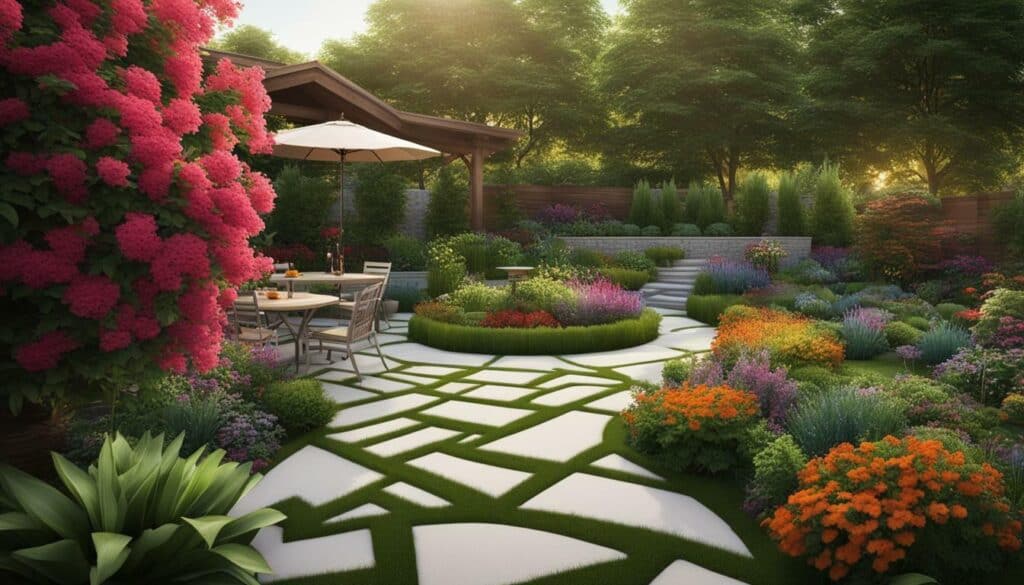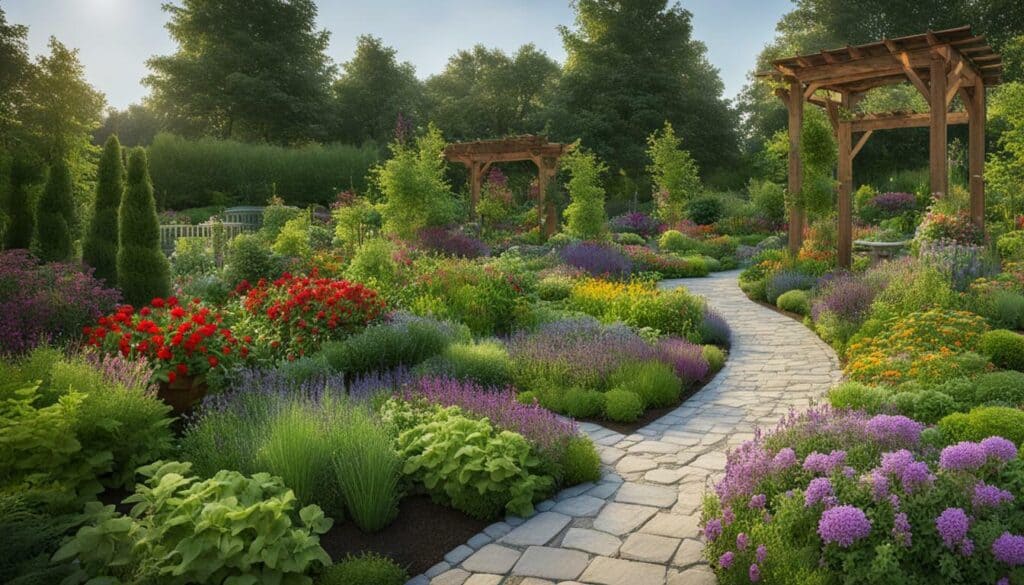Starting a garden from scratch in the UK can be both challenging and rewarding, but with the right garden design ideas, you can create a beautiful outdoor space.
Before diving into the process, it’s important to consider the structure of your garden. Elements like hedges, walls, fences, arches, gates, sculpture, containers, and topiary can play a crucial role in creating a visually appealing and functional garden.
For smaller gardens, simplicity is key. Incorporate three to five key elements to keep the design impactful yet manageable. When choosing hedges, consider options like yew or hornbeam, depending on your soil type. These hedges not only provide privacy but also act as a windbreak.
In larger gardens, creating different “rooms” with walls and hedges can add depth and character to the space. It also creates a sense of privacy and allows for the creation of open views. Consider incorporating arches and gates to add romance and stopping points within the garden.
Maximizing space in larger gardens is another crucial aspect. An open view with shorter divisions like retaining walls and low hedging can make the garden feel more spacious. Additionally, using hedges or fences to cut off the view of most of the garden can create the illusion of a longer space.
When it comes to choosing the right plants, consider the right plant for the right place. Focus on perennials that will plump up in a year or so, while climbing plants like roses and clematis may take longer to establish. Creating garden beds involves clearing old vegetation and ensuring good soil quality for healthy plant growth.
Essential tools and equipment such as hoes, rakes, shovels, and watering cans are necessary for garden maintenance. Regular watering and general upkeep are crucial to ensure the health and vitality of your plants.
Key Takeaways:
- Consider the structure of your garden, including elements like hedges, walls, fences, arches, and gates.
- Simplicity is key for smaller gardens, incorporating three to five key elements.
- Choose the right hedges for your soil type, such as yew or hornbeam.
- Create different “rooms” in your garden using walls and hedges.
- Maximize space in larger gardens with open views and shorter divisions.
Starting a garden from scratch in the UK requires careful planning and attention to detail. By incorporating these design ideas and following proper maintenance practices, you can create a beautiful and thriving outdoor space to enjoy for years to come.
Considering the Structure of Your Garden
Before you embark on creating your garden, it’s important to consider the structural elements that will define its overall look and feel. From hedges and walls to arches and gates, these features play a crucial role in shaping the aesthetics and functionality of your outdoor space.
When it comes to smaller gardens, simplicity is key. By incorporating three to five key elements, you can create a visually appealing design without overwhelming the limited space. Think about how hedges, fences, and containers can be strategically placed to maximize the impact.
For larger gardens that feature slopes or multiple levels, an open view with shorter divisions like retaining walls and low hedging can work wonders. This design technique not only creates an illusion of a longer space but also adds depth and dimension to your garden.
Adding arches and gates can infuse a touch of romance into your garden, serving as visual focal points and inviting visitors to explore what lies beyond. Sculpture and topiary can also add artistic flair, transforming your garden into a unique and captivating outdoor sanctuary.
| Type | Function |
|---|---|
| Hedges | Create privacy, define boundaries |
| Walls | Provide structure, retain soil |
| Fences | Add security, complement the overall design |
| Arches | Add architectural interest, frame views |
| Gates | Control access, add a sense of entrance |
| Sculpture | Add artistic flair, create focal points |
| Containers | Bring plants to different levels, create versatility |
| Topiary | Add shape and form, create a classic look |
Remember, the structural elements you choose for your garden should not only enhance its visual appeal but also serve a functional purpose. By carefully considering hedges, walls, fences, arches, gates, sculpture, containers, and topiary, you can create a garden that reflects your personal style and is a joy to spend time in.

Dividing Your Garden with Walls and Hedges
One way to transform your garden is by creating distinct “rooms” with the help of walls and hedges. This technique allows you to divide your outdoor space into different areas, each with its own purpose and atmosphere. By strategically placing walls and hedges, you can create a sense of privacy and seclusion, while still maintaining an open view of the entire garden.
Retaining walls can be used to separate different levels of your garden, adding dimension and visual interest. Low hedging can serve as a border, marking the boundaries of each “room” and guiding visitors through the garden. These structural elements not only enhance the aesthetics of your garden but also act as windbreaks, protecting delicate plants and providing a sense of shelter.
So, whether you have a small or large garden, don’t overlook the importance of the structural elements. Consider hedges, walls, fences, arches, gates, sculpture, containers, and topiary as your design toolkit, and create a garden that is not only visually stunning but also functional and inviting.
Designing Small Gardens
If you have a smaller garden, don’t let that limit your creativity – with some clever design choices, even the tiniest of spaces can become a stunning oasis. Keeping the design simple and focusing on three to five key elements can make a big impact in a small area.
One way to maximize the space in a small garden is by incorporating vertical elements. Consider adding trellises or vertical gardens that allow plants to grow upwards, creating a beautiful visual display while taking up minimal floor space. Hanging baskets and window boxes are also great options for adding a touch of greenery without cluttering the ground.
Another strategy for designing small gardens is to use mirrors strategically. Placing a mirror on a wall or fence can create the illusion of a larger space by reflecting the existing garden and making it appear double in size. This simple trick can instantly make your small garden feel more spacious and open.

When it comes to plant selection, opt for varieties that are well-suited to smaller spaces. Choose compact plants that won’t outgrow their allotted areas and consider multi-functional plants that offer both beauty and functionality. For example, herbs like thyme and rosemary not only add fragrance and charm to your garden but can also be used in your culinary creations.
In summary, designing a small garden requires careful planning and smart choices. By keeping the design simple, incorporating vertical elements, using mirrors strategically, and selecting the right plants, you can transform your small space into a stunning oasis that brings joy and beauty to your outdoor living.
Choosing the Right Hedges and Fences
Hedges and fences not only provide privacy but also play a crucial role in defining the boundaries and aesthetics of your garden. When starting a garden from scratch, it’s important to carefully select the right hedges and fences that will complement the overall design and suit your specific needs.
Depending on the soil type and desired height, yew and hornbeam are popular choices for creating hedges. Yew is known for its dense foliage and is ideal for formal gardens, while hornbeam offers a more natural and informal look. Consider consulting with a local gardening expert to determine which hedge variety is best suited for your soil type and garden style.
If your garden is susceptible to strong winds, hedges and fences can also serve as effective windbreaks. They create a barrier that reduces the impact of harsh winds, protecting delicate plants and ensuring the longevity of your garden. Additionally, hedges and fences act as natural screens, providing privacy from neighboring properties.
Remember to maintain your hedges and fences regularly to keep them looking their best. Pruning and trimming will not only enhance their aesthetics but also encourage healthy growth. With the right choice of hedges and fences, you can create a beautiful and functional garden that brings joy and tranquility to your outdoor space.
| Hedge Type | Soil Type |
|---|---|
| Yew | Well-drained soil |
| Hornbeam | Moist, well-drained soil |
Creating Different “Rooms” with Walls and Hedges
One of the secrets to a captivating garden design is to create distinct “rooms” that offer unique experiences within the larger space. By dividing the garden with walls and hedges, you can achieve a sense of intimacy and intrigue. Walls can provide structure and serve as a backdrop for beautiful climbing plants, while hedges can act as living partitions, creating privacy and defining different areas.
Open views are important in garden design as they create a sense of depth and connection with the surroundings. However, it’s equally important to strike a balance and create intimate spaces within the garden. Retaining walls can be used to create terraces or raised beds, adding visual interest and functionality. Low hedging can be used to separate different “rooms” without blocking the view entirely.
| Dividing the Garden | Creating Rooms | Open Views | Retaining Walls | Low Hedging |
|---|---|---|---|---|
| Offers a sense of privacy and structure. | Creates distinct areas within the garden. | Provides a connection with the surroundings. | Adds visual interest and functionality. | Separates spaces without blocking the view. |
Addi
Maximizing Space in Larger Gardens
If you’re fortunate enough to have a larger garden, there are clever strategies you can employ to make the most of the space available. By carefully considering the layout and design, you can create an open view that gives the illusion of a more spacious area. One effective method is to utilize shorter divisions, such as retaining walls and low hedging, which can help break up the space while maintaining a sense of openness.
By strategically placing hedges or fences to cut off the view of most of the garden, you can create the perception of a longer space. This technique is especially useful if your garden slopes upwards, as it can effectively maximize the available room and create visual interest. The key is to carefully plan the positioning of these elements to create a harmonious flow throughout the space.

When designing a larger garden, it’s important to consider the shape of the space and plan accordingly. Adding architectural features, such as arches and gates, can add romance and create beautiful stopping points within the garden. These elements not only enhance the aesthetics but also help to break up the space and create a sense of progression as you move through different areas.
Creating an Open View with Shorter Divisions
One effective way to create an open view in a larger garden is to utilize shorter divisions, such as retaining walls and low hedging. These elements can divide the space into distinct areas while maintaining a sense of openness and flow. For example, you can create separate zones for entertaining, relaxation, or growing different types of plants.
| Shorter Divisions | Benefits |
|---|---|
| Retaining Walls | Provide structural support for changes in elevation and create terraced areas for planting. |
| Low Hedging | Act as natural borders, define spaces, and create privacy while still allowing for an open feel. |
By strategically incorporating and combining these elements, you can make the most of the available space in your larger garden. Remember to select materials and plants that complement each other and enhance the overall design.
Creating an open view with shorter divisions is just one of the many strategies you can employ to maximize space in a larger garden. By carefully designing and organizing different areas, you can achieve a harmonious balance between functionality and aesthetics, creating a truly remarkable outdoor space to enjoy and appreciate.
Incorporating Greenhouses and Long Borders
If you’re passionate about gardening, having a greenhouse can be a game-changer, providing you with a controlled environment for growing a variety of plants. Whether you want to extend the growing season, start seeds early, or protect delicate plants from harsh weather conditions, a greenhouse is a valuable addition to any garden.
A greenhouse offers protection from extreme temperatures and frost, allowing you to cultivate a diverse range of plants that may not thrive in your local climate. With the ability to control temperature, humidity, and ventilation, you can create the perfect conditions for seed germination, plant growth, and even year-round harvesting.

When incorporating a greenhouse into your garden design, consider the available space and how it can be maximized. For instance, long borders alongside the greenhouse can make good use of the extra width. These borders can be filled with a variety of colorful flowers, herbs, or vegetables, creating a stunning visual display and maximizing your gardening potential.
Long borders can be designed in a straight or curved shape, depending on your personal preference and the overall aesthetics of your garden. They provide an opportunity to add depth and structure to your outdoor space, making it more visually appealing and inviting.
Tips for Creating Long Borders:
- Choose plants of varying heights to add interest and create a natural flow.
- Consider color combinations for a visually striking display.
- Incorporate evergreen plants for year-round interest.
- Allow enough space between plants for growth and proper air circulation.
By incorporating a greenhouse and creating long borders, you can transform your garden into a vibrant and productive oasis. Whether you’re a seasoned gardener or just starting out, these additions will enhance your gardening experience and provide endless opportunities for creativity and enjoyment.
| Pros of Greenhouses: | Cons of Greenhouses: |
|---|---|
| Extended growing season | Higher cost of installation and maintenance |
| Protection from extreme weather conditions | Requires regular monitoring and maintenance |
| Control over temperature, humidity, and ventilation | Limited space for larger plants or trees |
| Ability to grow a wider variety of plants | Potential for pest and disease issues |
Choosing the Right Plants
When it comes to planting your garden, selecting the right plants is key to ensuring their success and longevity. Whether you have a small or large garden, the right plant choices can make all the difference in creating a beautiful and thriving outdoor space.
When designing your garden, consider the specific needs of each plant. Choose the right plant for the right place, taking into account factors such as sunlight, soil conditions, and climate. This will help to ensure that your plants have the best chance of flourishing.
Perennials are a popular choice for many gardeners, as they will come back year after year, adding color and interest to your garden. They require less maintenance and can fill out and bloom in just a year or so. Climbing plants, such as roses and clematis, may take a bit longer to establish, but they can create stunning vertical interest in your garden.
| Plant | Sunlight | Soil Conditions | Climate |
|---|---|---|---|
| Perennials | Full sun to partial shade | Well-drained soil | Varies |
| Climbing plants | Full sun to partial shade | Moist, well-drained soil | Varies |
Remember to consider the shape and size of the plants as well, ensuring that they complement the overall design of your garden. Proper spacing is important to allow for growth and prevent overcrowding.

Creating Garden Beds and Ensuring Good Soil Quality
Before you can start planting, it’s essential to establish well-prepared garden beds that provide the ideal conditions for your plants to thrive. Clearing old vegetation and ensuring good soil quality are crucial steps in this process.
Firstly, remove any existing plants, weeds, and grass from the area where you plan to create your garden beds. This can be done by manually digging them out or using a garden fork to loosen the soil and remove the roots.
| Tip: | Consider using a weed fabric to prevent weed growth in your garden beds. Simply lay the fabric over the cleared area before adding soil, ensuring that the fabric is covered completely. |
|---|
Next, assess the soil quality in your garden beds. Good soil is the foundation for healthy plant growth. It should be well-draining, rich in organic matter, and have a balanced pH level.
To improve the soil quality, incorporate organic matter such as compost or well-rotted manure. This will enrich the soil, improve its structure, and increase its ability to retain moisture. Spread a layer of organic matter over the cleared area and mix it into the existing soil using a garden fork or a tiller.
| Fact: | Organic matter improves soil fertility, enhances microbial activity, and provides essential nutrients to plants. |
|---|
Once the organic matter is mixed in, rake the soil to create a smooth and level surface for planting. Ensure that the soil is slightly moist but not waterlogged before proceeding with planting.

Now that you have well-prepared garden beds with good soil quality, you are ready to start planting and watching your garden flourish!
Summary:
- Clear old vegetation and remove any weeds or grass from the area.
- Consider using a weed fabric to prevent weed growth in your garden beds.
- Assess the soil quality and improve it by incorporating organic matter such as compost or well-rotted manure.
- Rake the soil to create a smooth and level surface for planting.
Remember, establishing well-prepared garden beds is a vital step in creating a thriving garden.
Essential Tools and Maintaining Your Garden
As a gardener, having the right tools and knowing how to maintain your garden are essential for keeping your plants happy and healthy. Here are some of the essential tools you’ll need:
- Hoes: Ideal for breaking up soil and removing weeds.
- Rakes: Great for leveling soil and clearing debris.
- Shovels: Necessary for digging holes and moving soil.
- Watering cans: Essential for watering your plants.
It’s important to select high-quality tools that are comfortable to use and suited to your individual needs. Invest in sturdy, well-made tools that will last for years.
Once you have the right tools, regular maintenance is key to keeping your garden in top shape. Here are some maintenance tasks to keep in mind:
- Watering: Ensure your plants receive adequate water, especially during dry spells. Consider using mulch to retain moisture and prevent weeds.
- Pruning: Regularly prune your plants to promote healthy growth and maintain their shape. Remove dead or diseased branches to prevent the spread of disease.
- Fertilizing: Feed your plants with the appropriate fertilizer to provide them with necessary nutrients. Follow the instructions on the packaging for the correct application.
- Weeding: Keep your garden free from weeds by regularly removing them. This will prevent them from competing with your plants for nutrients and water.
By investing in the right tools and staying on top of regular maintenance, you’ll create an environment where your plants can thrive. Remember to enjoy the process and take pride in your beautiful garden!
| Tool | Function |
|---|---|
| Hoes | Breaking up soil and removing weeds |
| Rakes | Leveling soil and clearing debris |
| Shovels | Digging holes and moving soil |
| Watering Cans | Watering your plants |
Enjoying Your Completed Garden
Now that you’ve put in the hard work, it’s time to sit back, relax, and fully enjoy the fruits of your labor. Your completed garden is a testament to your dedication and love for nature. It’s a space where you can find solace, reconnect with the earth, and marvel at the beauty you’ve created.
Take a moment to bask in the tranquility of your garden oasis. Listen to the birds chirping, feel the gentle breeze rustling through the leaves, and savor the scents of blooming flowers. This is your sanctuary, a place where you can escape the hustle and bustle of everyday life.
To make the most of your garden, ensure that it remains a haven of peace and harmony. Implement pest control measures to protect your plants from unwanted visitors. Remember to use natural methods whenever possible, as they are safer for the environment and your health.
Additionally, consider using weed fabric to prevent weed growth and maintain a tidy and well-maintained garden. Weed fabric acts as a barrier, preventing weed seeds from germinating and taking over your precious flower beds and borders.

With these measures in place, you can now spend more time enjoying your garden and less time tending to its upkeep. Find a comfortable spot among the lush greenery, bring a good book or a cup of tea, and simply revel in the serenity that your garden provides.
| Key Tips for Enjoying Your Garden: |
|---|
| 1. Create a seating area: Set up a cozy space where you can unwind and admire the beauty around you. Whether it’s a rustic wooden bench, a hammock, or a set of lounge chairs, make sure it’s comfortable and invites you to relax. |
| 2. Incorporate sensory elements: Appeal to all your senses by including fragrant flowers, wind chimes, and a small water feature that creates a soothing sound. These sensory elements will heighten your experience in the garden. |
| 3. Invite wildlife: Attract birds, butterflies, and bees to your garden by planting nectar-rich flowers and providing a water source. Watching these creatures go about their daily activities will bring joy and a sense of connection to the natural world. |
| 4. Host gatherings: Your garden can also be a place of celebration and togetherness. Organize small gatherings with friends and family, enjoying meals al fresco or simply sharing stories amidst the beauty of nature. |
Your garden is a work of art, a labor of love that brings you immense joy and satisfaction. Cherish this space, nurture it, and let it be a constant source of inspiration and happiness in your life.
Conclusion
Starting a garden from scratch in the UK is a fulfilling journey that allows you to create a beautiful haven right outside your doorstep. It begins with considering the structure of your garden, incorporating elements like hedges, walls, fences, arches, gates, sculpture, containers, or topiary. In smaller gardens, simplicity is key, focusing on three to five key elements. When choosing hedges, options like yew or hornbeam depend on the soil type, while also serving as windbreaks.
Dividing your garden with walls or hedges can create different “rooms” and add depth to the space. Adding arches and gates can add romance and provide stopping points for exploration. Meanwhile, for larger gardens with slopes, open views with shorter divisions like retaining walls and low hedging work effectively. By using hedges or fences to cut off the view, an illusion of a longer space can be created.
With the shape of the garden in mind, incorporating a greenhouse or creating long borders can maximize the space and make good use of extra width. Breaking up the space in the garden can make it appear larger and more spacious. When choosing plants, consider the right plant for the right place and focus on perennials that will flourish in a year or so. Climbing plants like roses and clematis may take longer to establish but are worth the wait.
Garden beds should be created by clearing old vegetation and ensuring good soil quality. Essential tools such as hoes, rakes, shovels, and watering cans will help maintain your garden’s health. Proper spacing and regular watering are necessary for healthy plant growth. And don’t forget to use weed fabric to prevent unwanted growth and implement pest control measures to protect your plants.
Once your garden is complete, take the time to savor and enjoy the beauty you have created. Whether it’s a peaceful retreat, a vibrant floral display, or a productive vegetable patch, your garden will be a source of joy and fulfillment for years to come.
What Are Some Tips for Starting a Garden as a Hobby in the UK?
Starting gardening as a hobby in the UK can be a rewarding experience. Begin by selecting the right location for your garden, ensuring it gets enough sunlight and has good drainage. Choose a variety of plants suited to the UK climate and consider using organic methods for pest control. Regular watering, pruning, and composting will help your garden thrive. Don’t be afraid to experiment and learn from your mistakes, as gardening is a never-ending process of growth and discovery.
FAQ
Q: What should I consider before starting a garden from scratch in the UK?
A: It is important to consider the structure of the garden, such as hedges, walls, fences, arches, gates, sculpture, containers, or topiary.
Q: How can I design a small garden?
A: Keep it simple and incorporate three to five key elements.
Q: What are good options for hedges in the UK?
A: Yew or hornbeam are good options depending on the soil type.
Q: How can I create different “rooms” in my garden?
A: Divide the garden with a wall or hedge to create different “rooms” and act as a windbreak.
Q: How can I maximize space in a larger garden?
A: Create an open view with shorter divisions like retaining walls and low hedging.
Q: What should I consider when choosing plants for my garden?
A: Choose the right plant for the right place and focus on perennials that will plump up in a year or so.
Q: How do I create garden beds and ensure good soil quality?
A: Clear old vegetation and ensure good soil quality before creating garden beds.
Q: What tools do I need to maintain my garden?
A: Essential tools include hoes, rakes, shovels, and watering cans.
Q: How can I prevent weed growth in my garden?
A: Use weed fabric to prevent weed growth.
Q: How can I enjoy my completed garden?
A: Implement pest control measures and savor the joy and beauty of your completed garden.





Leave a Reply